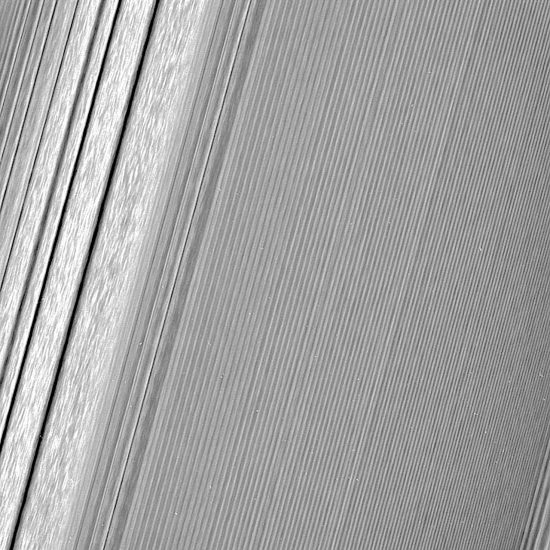
September 24, 2020
New insights from four Cassini instruments reveal mysteries in Saturn’s rings.
Saturn’s rings are approximately 416,000 kilometers wide, but are estimated to be a mere 50 meters thick, possibly as little as 10 meters. This means that Earth-based telescopes detect only a thin wire extending across the planet when they are edge-on. Astronomers think the rings formed from the original nebular cloud out of which the planet condensed. A small moon or an asteroid was then destroyed by Saturn’s gravity, leaving the fragments in orbit. Regardless of how they evolved, they are theorized to be over four billion years old—almost as old as the Solar System.
Saturn’s equinox passed in August of 2009, so the rings are now shifted to the north. The reason for the ring tilt is that Saturn, itself, is tilted on its axis by 27.4 degrees. Since the rings are tilted at the same angle, as Saturn revolves around the Sun in its 30 year orbit, it gradually brings them into visual alignment with its equator.
According to a recent press release, data from Cassini’s Ring Grazing Orbits (December 2016 to April 2017) and the Grand Finale (April to September 2017) include images that seem to indicate some gravitational influences in the ring plane are sculpting the rings. Previous Picture of the Day articles discuss some of the strangest formations: “propellors”, walls up to 16 kilometers high perpendicular to the rings, clumps, and twisted filaments.
In an Electric Universe, planets and moons do not exist in an electrically neutral environment. Saturn, in particular, has a family of moons that exhibit electric discharge machining on a vast scale, as well as features within its atmosphere that could be characterized as lightning discharges. The aurorae on Saturn emit intense radio waves and the planet is surrounded by a torus of plasma that emits X-rays and extreme ultraviolet light. Saturn displays many aspects that are predicted by the Electric Universe theory, including the shape of its rings. In 1913 Kristian Birkeland wrote: “It seems almost incredible that such a ring of cosmic dust should be able to exist for ever, so to speak, without other governing forces than gravitation…”
As mentioned, gravity-only models of the Solar System insist that Saturn’s rings were created, held and shaped by the activity of “shepherd moons” and angular momentum. Instead, electrical forces that are orders of magnitude more powerful than gravity seem more likely.
Saturn is an electrical environment, experiencing everything from dark-mode plasma discharges, to gigantic lighting bolts that flash across the ring plane. When the Cassini-Huygens spacecraft got close enough to finally start observing Saturn, planetary scientists were shocked to discover lightning of immense power, up to a million times more powerful than anything on Earth. Indeed, 90 megawatts of X-rays are shining from the planet. The discovery was “surprising.” The reason for the surprise was that they ignored the fact that planets with magnetic fields can capture ionized particles to form a giant electrified magnetosphere.
Saturn emits 2.3 times more energy than it receives from the Sun, so it is being powered by an external source. It is also probable that the interior of the planet has its own heat. There is good evidence that Saturn once existed as an independent body from the Sun. As such, it would have received more energy in the recent past, its power source having since been usurped by the Sun.
According to ancient legends, Saturn occupied a position of prominence in the sky. It was not the tiny pinprick of light that can be seen on dark nights. Rather, it was worshipped as the central luminary, the all-powerful Sun. If that was the case, then its current position in the Solar System is far removed from what it was.
Without going into details that are elaborated elsewhere, that disturbance and rearrangement of planets means that Saturn is the way it is not because of how the mainstream believes it was formed, but because it is closer to being a star than it is to being a planet. Indeed, as our ancestors tell us, it was a star.
Stephen Smith
The Thunderbolts Picture of the Day is generously supported by the Mainwaring Archive Foundation.












